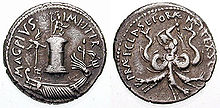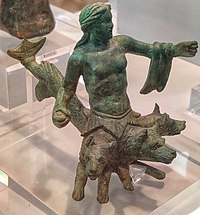Scylla

InGreek mythology,Scylla[a](/ˈsɪlə/SIL-ə;Greek:Σκύλλα,translit.Skýlla,pronounced[skýlːa]) is a legendary, man-eating monster who lives on one side of a narrow channel of water, opposite her counterpart, the sea-swallowing monsterCharybdis.The two sides of the strait are within an arrow's range of each other—so close that sailors attempting to avoid the whirlpools of Charybdis would pass dangerously close to Scylla and vice versa.
Scylla is first attested inHomer'sOdyssey,whereOdysseusand his crew encounter her and Charybdis on their travels. Later myth provides an origin story as a beautiful nymph who gets turned into a monster.[2]
Book Three ofVirgil'sAeneid[3]associates the strait where Scylla dwells with theStrait of MessinabetweenCalabria,a region ofSouthern Italy,andSicily.The coastal town ofScillain Calabria takes its name from the mythological figure of Scylla and it is said to be the home of the nymph.
The idiom "between Scylla and Charybdis"has come to mean being forced to choose between two similarly dangerous situations.
Parentage[edit]

The parentage of Scylla varies according to author.[4]Homer,Ovid,Apollodorus,Servius,and a scholiast on Plato, all nameCrataeisas the mother of Scylla.[5]Neither Homer nor Ovid mentions a father, but Apollodorus says that the father was either Trienus (probably a textual corruption ofTriton) or Phorcus (a variant ofPhorkys).[6]Similarly, the Plato scholiast, perhaps following Apollodorus, gives the father as Tyrrhenus or Phorcus,[7]whileEustathiuson Homer,Odyssey12.85, gave the father as Triton, orPoseidonand Crateis as the parents.[8]
Other authors haveHecateas Scylla's mother. TheHesiodicMegalai Ehoiaigives Hecate andApolloas the parents of Scylla,[9]whileAcusilaussays that Scylla's parents were Hecate and Phorkys (so also schol.Odyssey12.85).[10]
Perhaps trying to reconcile these conflicting accounts,Apollonius of Rhodessays that Crataeis was another name for Hecate, and that she and Phorcys were the parents of Scylla.[11]Likewise,Semos of Delos[12]says that Crataeis was the daughter of Hecate and Triton, and mother of Scylla by Deimos.Stesichorus(alone) names Lamia as the mother of Scylla, possibly theLamiawho was the daughter of Poseidon,[13]while according toHyginus,Scylla was the offspring ofTyphonandEchidna.[14]
Narratives[edit]

According toJohn Tzetzes[15]andServius'commentary on theAeneid,[16]Scylla was a beautifulnaiadwho was claimed by Poseidon, but the jealousNereidAmphitriteturned her into a terrible monster by poisoning the water of the spring where Scylla would bathe.
A similar story is found inHyginus,[17]according to whom Scylla was loved byGlaucus,but Glaucus himself was also loved by the goddess sorceressCirce.While Scylla was bathing in the sea, the jealous Circe poured a baleful potion into the sea water which caused Scylla to transform into a frightful monster with six dog forms springing from her thighs. In this form, she attacked Odysseus' ship, robbing him of his companions.
In a late Greek myth, recorded inEustathius' commentary on Homer and John Tzetzes,[18]Heraclesencountered Scylla during a journey to Sicily and slew her. Her father, the sea-godPhorcys,then applied flaming torches to her body and restored her to life.
Homer'sOdyssey[edit]

In Homer'sOdysseyXII,Odysseusis advised by Circe to sail closer to Scylla, for Charybdis could drown his whole ship: "Hug Scylla's crag—sail on past her—top speed! Better by far to lose six men and keep your ship than lose your entire crew."[19]She also tells Odysseus to ask Scylla's mother, the river nymphCrataeis,to prevent Scylla from pouncing more than once. Odysseus successfully navigates the strait, but when he and his crew are momentarily distracted by Charybdis, Scylla snatches six sailors off the deck and devours them alive.
...they writhed
gasping as Scylla swung them up her cliff and there
at her cavern's mouth she bolted them down raw—
screaming out, flinging their arms toward me,
lost in that mortal struggle.[20]
Ovid'sMetamorphoses[edit]

According toOvid,[21]the fisherman-turned-sea godGlaucus falls in love with the beautiful Scylla, but she is repulsed by his piscine form and flees to apromontorywhere he cannot follow. When Glaucus goes to Circe to request a love potion that will win Scylla's affections, the enchantress herself becomes enamored with him. Meeting with no success, Circe becomes hatefully jealous of her rival and therefore prepares a vial of poison and pours it into the sea pool where Scylla regularly bathed, transforming her into a thing of terror even to herself.
|
The story was later adapted into a five-act tragic opera,Scylla et Glaucus(1746), by the French composerJean-Marie Leclair.
Keats'Endymion[edit]
InJohn Keats' loose retelling of Ovid's version of the myth of Scylla and Glaucus in Book 3 ofEndymion(1818), the evil Circe does not transform Scylla into a monster but merely murders the beautiful nymph. Glaucus then takes her corpse to a crystal palace at the bottom of the ocean where lie the bodies of all lovers who have died at sea. After a thousand years, she is resurrected byEndymionand reunited with Glaucus.[23]
Paintings[edit]

At the Carolingianabbey of Corveyin Westphalia, a unique ninth-century wall painting depicts, among other things, Odysseus' fight with Scylla.[b]This illustration is not noted elsewhere in medieval arts.[24]
In theRenaissanceand after, it was the story of Glaucus and Scylla that caught the imagination of painters across Europe. InAgostino Carracci's 1597 fresco cycle ofThe Loves of the Godsin theFarnese Gallery,the two are shown embracing, a conjunction that is not sanctioned by the myth.[c]More orthodox versions show the maiden scrambling away from the amorous arms of the god, as in theoil on copperpainting ofFillipo Lauri[d]and the oil on canvas bySalvator Rosain theMusée des Beaux-Arts de Caen.[e]
Other painters picture them divided by their respective elements of land and water, as in the paintings of the FlemishBartholomäus Spranger(1587), now in theKunsthistorisches Museum,Vienna.[f]Some add the detail ofCupidaiming at the sea-god with his bow, as in the painting ofLaurent de la Hyre(1640/4) in theJ. Paul Getty Museum[g]and that ofJacques Dumont le Romain(1726) at theMusée des beaux-arts de Troyes.[26]Two cupids can also be seen fluttering around the fleeing Scylla in the late painting of the scene by J. M. W. Turner (1841), now in theKimbell Art Museum.[h]
Peter Paul Rubensshows the moment when the horrified Scylla first begins to change, under the gaze of Glaucus (c.1636),[27]whileEglon van der Neer's 1695 painting in theRijksmuseumshows Circe poisoning the water as Scylla prepares to bathe.[i]There are also twoPre-Raphaelitetreatments of the latter scene byJohn Melhuish Strudwick(1886)[28]andJohn William Waterhouse(Circe Invidiosa,1892).[29]
Explanatory notes[edit]
- ^The Middle EnglishScylle(/ˈsɪliː/,reflectingGreek:Σκύλλη) is obsolete.
- ^via Wikimedia
- ^at Wikimedia
- ^MagnoliaboxArchived2014-03-22 at theWayback Machine
- ^View on theReproarte site;apreliminary drawingin MFA Boston is dated 1661
- ^Available inat Wikimedia
- ^View on the museum website[25]
- ^There is a more conventional print from around 1810/15 in theTate Gallery
- ^View onFlickr
Citations[edit]
- ^Ogden (2013),p. 132.
- ^Ogden (2013),pp. 130–131.
- ^Virgil (2007).Aeneid.Translated by Ahl, Frederick. Oxford University Press. pp.67.ISBN978-0-19-283206-1.
- ^For discussions of the parentage of Scylla, see Fowler,p. 32,Ogden, pp.134–135;Gantz, pp. 731–732; and Frazer's note 3 to Apollodorus,E.7.20
- ^Homer,Odyssey12.124–125;Ovid,Metamorphoses13.749;Apollodorus,E7.20;ServiusonVirgilAeneid3.420; schol. onPlato,Republic9.588c.
- ^Ogden,p. 135;Gantz, p. 731; Frazer's note 3 to Apollodorus,E.7.20
- ^Fowler,p. 32
- ^Eustathiuson Homer, p. 1714
- ^Hesiodfr. 200 Most[= fr. 262 MW] (Most, pp. 310, 311).
- ^Acusilaus.fr. 42 Fowler (Fowler,p. 32).
- ^Apollonius of Rhodes,Argonautica4. 828–829 (pp. 350–351).
- ^FGrHist396 F 22
- ^Stesichorus,F220PMG(Campbell, pp. 132–133).
- ^Hyginus,FabulaePreface&151
- ^adLycophron,45
- ^Servius onAeneidIII. 420.
- ^Hyginus,Fabulae199
- ^ad Lycophron,45
- ^Robert Fagles,The Odyssey1996, XII.119ff.
- ^Fagles 1996 XII.275–79.
- ^Ovid,Metamorphosesxiii. 732ff., 905; xiv. 40ff.; translation by Nicholas Rowe and Samuel Garth is inGoogleBooks
- ^Ovid,Metamorphosesxiv.51–2
- ^Endymion Book III,line 401ff – via Project Gutenberg
- ^"UNESCO: Corvey Abbey and Castle".
- ^"Glaucus and Scylla".
- ^View onFlickr
- ^Musée Bonat, available inat Wikimedia
- ^View onWikimedia
- ^Available on thewebsitedevoted to the artist
General and Cited References[edit]
- Apollodorus,Apollodorus, The Library, with an English Translation by Sir James George Frazer, F.B.A., F.R.S. in 2 Volumes.Cambridge, MA, Harvard University Press; London, William Heinemann Ltd. 1921.Online version at the Perseus Digital Library.
- Apollonius Rhodius(1912),The Argonautica,translated by Robert Cooper Seaton (trans 1912 ed.), W. Heinemann – via Internet Archive
- Campbell, David A.,Greek Lyric III: Stesichorus, Ibycus, Simonides, and Others,Harvard University Press, 1991.ISBN978-0674995253.
- Fowler, R. L.,Early Greek Mythography: Volume 2: Commentary,Oxford University Press, 2013.ISBN978-0198147411.
- Gantz, Timothy,Early Greek Myth: A Guide to Literary and Artistic Sources,Johns Hopkins University Press, 1996, Two volumes:ISBN978-0-8018-5360-9(Vol. 1),ISBN978-0-8018-5362-3(Vol. 2).
- Hanfmann, George M. A., "The Scylla of Corvey and Her Ancestors"Dumbarton Oaks Papers41"Studies on Art and Archeology in Honor of Ernst Kitzinger on His Seventy-Fifth Birthday" (1987), pp. 249–260.
- ,Gaius Julius,Fabulae,inThe Myths of,edited and translated by Mary A. Grant, Lawrence: University of Kansas Press, 1960.Online version at ToposText.
- Most, G.W.,Hesiod: The Shield, Catalogue of Women, Other Fragments,Loeb Classical Library,No. 503, Cambridge, Massachusetts,Harvard University Press,2007, 2018.ISBN978-0-674-99721-9.Online version at Harvard University Press.
- Ogden, Daniel (2013).Drakon: Dragon Myth and Serpent Cult in the Greek and Roman Worlds.Oxford University Press.ISBN9780199557325.
- Stesichorus,inGreek Lyric, Volume III: Stesichorus, Ibycus, Simonides, and Others.Edited and translated by David A. Campbell.Loeb Classical Library476.Cambridge, MA: Harvard University Press, 1991.
- Virgil,Aeneid.Translated by Frederick Ahl: Oxford University Press, 2007.
External links[edit]
- "Skylla".Theoi Project.– references in classical literature and ancient art.
- "Images of Scylla on Classical artefacts (Archive.org link)".Archived fromthe originalon 2011-09-28.
- Chisholm, Hugh,ed. (1911)..Encyclopædia Britannica.Vol. 24 (11th ed.). Cambridge University Press. p. 519.



